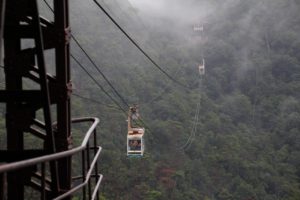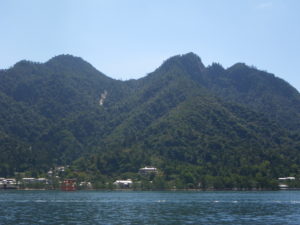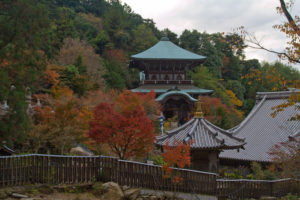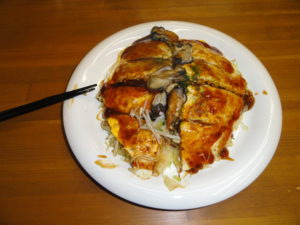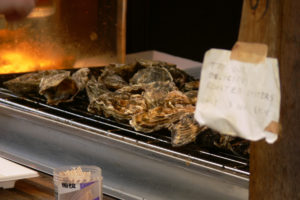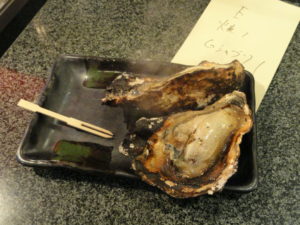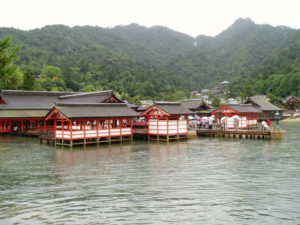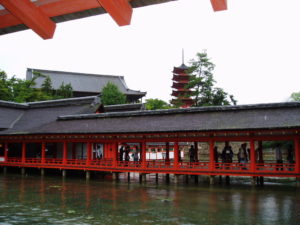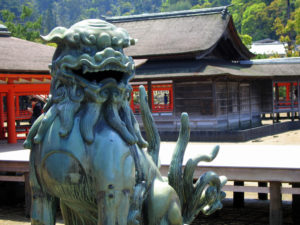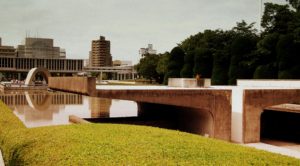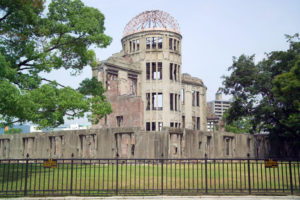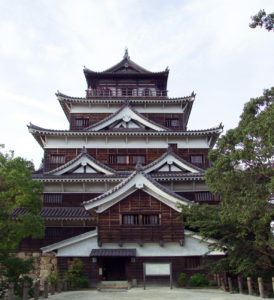Printable Sites Overview Itinerary & Daily Costs
Hiroshima & Miyajima
Day 7
August 7, 2022
Hiroshima, city, capital of Hiroshimaken (prefecture), southwestern Honshu, Japan. It lies at the head of Hiroshima Bay, an embayment of the Inland Sea. On August 6, 1945, Hiroshima became the first city in the world to be struck by an atomic bomb. Hiroshima, whose name means “broad island,” is situated on the delta of the Ōta River, whose six channels divide it into several islets. It was founded as a castle town by the feudal lord Mōri Terumoto in the 16th century. From 1868 onward it was a military center, which made it a potential target for Allied bombing during World War II. Reconstruction under a comprehensive city-planning scheme was begun about 1950 with the rebuilding of the Inari Bridge, and Hiroshima is now the largest industrial city in that section of Japan encompassed by the Chūgoku (western Honshu) and Shikoku regions. Hiroshima has become a spiritual center of the peace movement for the banning of nuclear weapons. A number of public hospitals and private clinics give free treatment to victims of the atomic bombing (hibakusha). Hiroshima Castle, destroyed in the bombing, was restored in 1957 and houses a museum of city history. Peace Memorial Park, located at the epicentre of the atomic blast, contains a museum and monuments dedicated to those killed by the explosion. The cenotaph for victims of the bombing is shaped like an enormous saddle, resembling the small clay saddles placed in ancient Japanese tombs; it contains a stone chest with a scroll listing the names of those killed. A commemorative service is held at the park every August 6th. The museum and cenotaph were designed by the Japanese architect Tange Kenzō, and two peace bridges at the park were sculpted by the American artist Isamu Noguchi. Millions of paper cranes, the Japanese symbol of longevity and happiness, are heaped about the Children’s Peace Monument throughout the year; that tradition was inspired by Sasaki Sadako, a 12-year-old girl who died, 10 years after the bombing, of leukemia contracted as an aftereffect of exposure to radiation. Atomic Bomb Dome (Genbaku dōmu), which was designated a UNESCO World Heritage site in 1996, is the remains of one of the few buildings not obliterated by the blast. (Britannica, T. Editors of Encyclopaedia (2020, October 5). Hiroshima. Encyclopedia Britannica. https://www.britannica.com/place/Hiroshima-Japan)
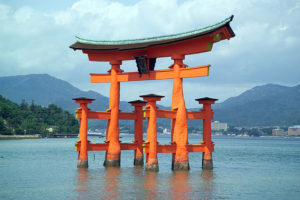
Miyajima
We will begin our day in the Hiroshima area by visiting Miyajima Island.
Itsuku Island (Itskushima), also called Miya Island (Miyajima), in English “Shrine Island”, an offshore island, Hiroshima ken (prefecture), Japan, in the Inland Sea. The small island, one of Japan’s most scenic locations, is 19 miles (31 km) in circumference and occupies an area of 12 square miles (31 square km). It is best known for its 6th-century shrine, which was built on tidal land and has the appearance of floating on the sea during high tide. It was named for one of the daughters of Susanowo, the Shintō storm god. Other of its religious buildings include the 9th-century temple that crowns Mount Mi (Misen), which rises to the island’s highest elevation, 1,739 feet (530 meters). Because of its religious significance, births and burials were long prohibited on Itsuku Island. The town of Miyajima on the island is a popular summer resort, with beaches, cherry trees, and tame deer. (Britannica, T. Editors of Encyclopaedia (2012, March 7). Itsuku Island. Encyclopedia Britannica. https://www.britannica.com/place/Itsuku-Island)
Mount Misen
At 500 meters above sea level, Mount Misen (弥山) is the highest peak on Miyajima. On clear days, it affords spectacular views of the Seto Inland Sea and as far as Hiroshima City. There are also a number of Buddhist structures near the peak. A ropeway leads up the mountain from town, but it is also possible to climb up on foot.
After riding the ropeway to Shishiwa station, we will climb to the summit of Mt. Misen and return to Miyajima by walking down the Daisho-in Course. There are three hiking trails leading down Misen: the Momijidani Course, the Daisho-in Course, and the Omoto Course. Of the three, the Daisho-in Course offers the nicest views and is not as steep as the other two. Using any course, it takes 1.5 to 2 hours to reach the town from the summit.
The final site on the Daisho-in Course is, of course, the Daisho-in Temple. Daisho-in (大聖院, Daishōin) is one of the most important temples of Shingon Buddhism. Daisho-in features a variety of buildings, statues and other religious objects for visitors to admire. An interesting Buddhist ritual can be performed when walking up the temple’s steps. Along the stairs is a row of spinning metal wheels that are inscribed with sutra (Buddhist scriptures). Turning the inscriptions as one walks up is believed to have the same effect as reading them. So, without any knowledge of Japanese, you can benefit from the blessings that the reading of sutra is believed to entail.
Miyajima Omotesando
After finishing our climb down Mt. Misen, it will be time for lunch and more sightseeing in the town of Miyajima. The Omotesando Shopping Arcade offers many restaurants and street vendors. If you like oysters, make sure to try them while in Miyajima!! Once done eating, feel free to explore the area including the Itsukushima Shrine and Floating Torii before we depart Miyajima.
Itsukushima Shrine & Floating Torii
The centuries-old Itsukushima Shrine (厳島神社, Itsukushima Jinja) on Miyajima is the source of both the island’s fame and its name. Formally named Itsukushima, the island is more popularly known as “Miyajima”, literally “shrine island” in Japanese, thanks to its star attraction. The shrine is known worldwide for its iconic “floating” torii gate.
The shrine and its torii gate are unique for being built over water, seemingly floating in the sea during high tide. The shrine complex consists of multiple buildings, including a prayer hall, a main hall and a noh theater stage, which are connected by boardwalks and supported by pillars above the sea.
Peace Memorial Park & Atomic Bomb Dome
A scenic 45 minute ferry ride brings us to the entrance for the Peace Memorial park. Hiroshima’s Peace Memorial Park (平和記念公園, Heiwa Kinen Kōen) is one of the most prominent features of the city. Even visitors not looking for it will likely stumble upon the large park of over 120,000 square meters. Its trees, lawns, and walking paths are in stark contrast to the surrounding downtown area.
The park’s main facility is the Peace Memorial Museum. Consisting of two buildings, the museum surveys the history of Hiroshima and the advent of the nuclear bomb. Its main focus though is on the events of August 6: the dropping of the bomb and its outcome in human suffering.
The A-Bomb Dome, also known as the Hiroshima Peace Memorial, is what remains of the former Prefectural Industrial Promotion Hall. The building served as a location to promote Hiroshima’s industries. When the bomb exploded, it was one of the few buildings to remain standing and remains so today. A UNESCO World Heritage Site, the A-Bomb Dome is a tangible link to Hiroshima’s unique past.
Hiroshima Castle
Our final site in Hiroshima will be Hiroshima Castle. Hiroshima Castle (広島城, Hiroshimajō), also called the Carp Castle, is a good example of a castle built on a plain in the center of a city as opposed to hilltop and mountaintop castles. Its main keep is five stories tall, and its grounds are surrounded by a moat. Also within the castle’s precincts are a shrine, some ruins and a few reconstructed buildings of the Ninomaru (second circle of defense).
ALTERNATE ACTIVITIES IN HIROSHIMA & MIYAJIMA
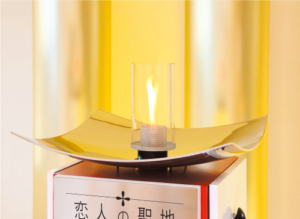
Fire Oath
Miyajima is being marketed as a “Lover’s Sanctuary” ! The “Fire of Oath” ceremony imparts “the joy and magic of encounters, blissful marriages and raising a happy home” at the mountaintop ropeway station.
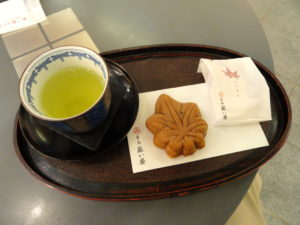
Momiji Manju Cake-Making Experience
Momiji manju (maple leaf bean buns) have been Miyajima’s most famous confectionary for about a hundred years, and are known nationwide as one of the prefecture’s most famous products. As the name suggests, they are castella cake buns in the shape of maple leaves, filled with sweet bean paste.
Here, you can try your hand at making your own maple leaf bean buns, experiencing the entire process from cooking the shell to filling it, under the guidance of an instructor.
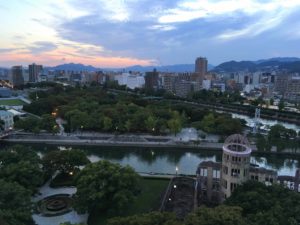
Orizuru Tower
Named after the folded paper crane, which is a symbol of peace, the Orizuru Tower is a facility located on the east side of the Atomic Bomb Dome. The rooftop observation deck provides panoramic views of Hiroshima City, and if the weather’s clear, you can even see as far as Miyajima.
In one section, you can learn the changes of Hiroshima townscape from before and after the bombing, as well as today, instilling a sense of hope and importance of peace.
The first floor offers cafés and shops where you can find Hiroshima specialties, making it an ideal place for shopping or taking a break.
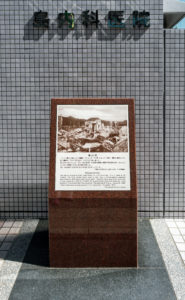
Atomic Bomb Hypocenter
The site of the hypocenter itself is marked only by a plaque showing a photo of the devastation which resulted and stating the bare facts. Visitors leave flowers and paper cranes in memory of the dead.
The plaque can be found less than five minutes’ walk from the A-Dome.
